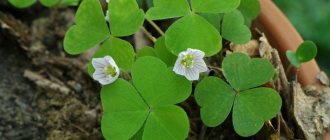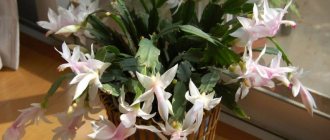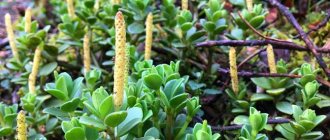Varieties of Decembrist flower
Initially, only 2 varieties of Decembrist were widespread - with white and with red flowers. The emergence of new varieties, the range of which is regularly replenished, is the merit of breeders.
The most famous varieties:
Rousseliana
A bush characterized by lush flowering and a tendency to branch, up to 30 cm high with long meter-long shoots. The petals of tubular flowers look like bells with long stamens.
Truncated
Spreading bush with light green long shoots. Multi-tiered flowers are decorated with pointed petals and a cascade of stamens. Color varies from lilac to white.
Buckley
Bush up to 40 cm high with dark green fleshy shoots. Flowers start from 8 cm in size. Color depends on the variety.
More than a hundred Decembrist hybrids have been bred. They are united in a series, the differences between which are only in the shades and sizes of the flowers. The conditions for growing Decembrist do not change.
How and when does Schlumbergera bloom?
The plant blooms once a year, just at the end of November and beginning of December, which is why the name is Decembrist. The period ends in January-February. If spring and summer were too hot, then Schlumbergera may bloom a little earlier - in October. In this case, the flowering period ends by the end of December.
At the beginning of flowering, buds are formed at the tip of each stem, from which flowers bloom within a few days, zygomorphic in shape with a pronounced tube. Outwardly, they resemble orchid inflorescences.
The color of Decembrist flowers can be either monochromatic or a combination of two shades. The color range is quite varied :
- white;
- citric;
- orange:
- pink;
- lilac;
- scarlet;
- violet.
Reference ! Under natural conditions, the color of the plant buds is red or white. Breeders presented a variety of shades of indoor Schlumbergers to flower growers.
Caring for the Decembrist at home
To grow a Decembrist flower, you need to know exactly what this exotic plant needs. On the one hand, it is unpretentious, despite its tropical origin. On the other hand, it is necessary to create favorable conditions for the plant to bloom every year.
Recommendations for growing Decembrist:
- ensure sufficiently high air humidity (by spraying);
- protect from direct sunlight, otherwise the shoots will turn red;
- do not use additional lighting, since the plant prefers short daylight hours;
- avoid waterlogging and drying out of the soil substrate;
- take it out onto the terrace in summer, place it in partial shade;
- protect the plant from drafts.
Let's talk in more detail about some of the features of growing Decembrist.
Lighting
Direct rays of the sun are pleasant for cacti. The Decembrist needs diffused light, but not a lack of lighting. A room with windows facing north is a good place to place a flower pot. He will also like the humidity of the kitchen and bathroom.
Watering
The frequency of watering depends on the stage of flower development. For irrigation, use settled water at room temperature. From October to January, when the period of budding and subsequent flowering begins, the plant needs abundant watering, but liquid should not be allowed to stagnate in the pan.
Humidity
Decembrist likes high humidity. For rapid growth and abundant flowering, regularly spray the plant or use a humidifier.
Temperature
The flower does not like temperature changes; it also does not like excessive heat and cold. The optimal temperature range is +15...+25 degrees with an air humidity of 75%. During budding, it is useful to carry out hardening on the balcony at a temperature of about +15 degrees.
Top dressing
Caring for and growing Decembrist at home cannot be imagined without regular feeding. A complex fertilizer for cacti is suitable for this purpose. Feeding is carried out according to the following scheme:
- From February to March, when the flower is resting, it is enough to just slightly moisten the soil. To prevent the soil substrate from drying out, the tray is lined with expanded clay and moss. No fertilizing is carried out during this period.
- From April until the end of summer, the Christmas tree enters the active growing season. At this time, it requires regular moderate watering. You can add ammonia to the water at the rate of 1 tsp. for 1 liter of water. Fertilizing is applied once every 2 weeks. The main components are NPK complex. The dosage of the drug intended for fertilizing home flowers is divided in half.
- In September, the plant is preparing to bloom, which means it’s time to limit watering, remembering to wet the moss in the tray to maintain optimal humidity. As soon as the buds appear, begin to intensively water and fertilize.
Transfer
Although the plant grows slowly, growing Decembrist does not exclude replanting the plant. If you buy a plant in a pot and there are roots sticking out of the drainage hole, replanting must be done immediately. If the roots are not visible, it can be postponed until the flower is 5 years old.
This is best done at the end of the flowering period. The roots of the plant are superficial and poorly developed, so a wide, shallow pot is suitable. In a container that is too spacious, the roots will actively grow to the detriment of flowering.
Transplanting an adult plant begins by filling the pot ⅓ full with drainage. The remaining ⅔ is occupied by compacted soil. The flower is moved from the old pot to the new one after thoroughly cleaning the roots from the old soil mixture. After this, all that remains is to carefully sprinkle the roots with soil and lightly water them. As the substrate settles, you can add a little more.
Trimming
Young plants do not require plucking (pruning). You can only remove buds that have bloomed. After flowering ends, the crown of adult bushes is formed. Knives are not used for this, but simply carefully remove faded, flaccid shoots and wilted buds with your hands.
Reproduction
Most often, propagation is carried out by cuttings, in rare cases by grafting onto succulents. In any case, shoots without diseases and damage are chosen for this. How to grow Decembrist from cuttings? You can immediately root them in the soil or place them in water first. In the second case, the process is accelerated.
Useful video
We invite you to watch a video on how to achieve Decembrist flowering at home:
If you find an error, please select a piece of text and press Ctrl+Enter.
The houseplant “Decembrist” or forest cactus got its name for its incredibly beautiful and lush flowering, which in most cases continues into December. In winter, the plant brings a piece of spring into the house, lifts the mood and decorates the room. But it also happens that a house pet suddenly does not bloom, and the reasons for this are unknown. In fact, you just need to follow the basic rules of caring for indoor flowers throughout the year. Decembrist is considered an unpretentious and non-capricious plant. And if it does not bloom, then it is necessary to find out what exactly the flower does not like and urgently take measures to create a favorable atmosphere.
Diseases and pests
The flower is immune to most pests and diseases, unless, of course, it is healthy. But against the background of excess or deficiency of watering, as well as in the case of proximity to diseased plants, the Decembrist’s immunity decreases.
Preparations that will help in pest control:
- spider mites - “Fitoverm”, “Vertimek”, “Aktofit”;
- mealybug - “Aktara”, “Konfidor”;
- scale insects - insecticides.
What to do to make the Decembrist flower bloom
Caring for a flower all year round will yield results; closer to December you will see how it is preparing to put out buds and bloom. To make Decembrist bloom, preparation for flowering is carried out throughout the year, and especially in the autumn months.
Let's take a closer look at caring for the plant by month.
March and April
Caring for Decembrist and preparing for flowering begins in the spring, when pruning is done for lush flowering. Its peculiarity is not to use scissors, but only break off the outer segments with your hands. The flower produces buds only on young shoots, so if you do not prune, it will not bloom.
Important! Remove the sheet strictly to the knee! It is not permissible to leave half a leaf - it will lead to the branch drying out and dying.
At this time, you can transplant the flower into another pot (preferably it is flat and not large in size), change the soil (soil intended for planting orchids is well suited for the Decembrist). But if the plant is kept in good conditions, then you should not disturb it. It is necessary to loosen the soil carefully, trying not to touch the roots.
May and June
At this time, care consists of ensuring proper lighting.
The window sill must be shaded from direct sunlight.
- Fertilizing with mineral fertilizers once a month.
- Replace watering with spraying leaves.
- The air temperature is not higher than 27 degrees.
Important! If you do everything correctly, new branches will begin to appear on the broken shoots.
July and August
During this period, feeding of the Decembrist is stopped. Leave watering, temperature and lighting in the same mode. You can take it out into the garden and move it from place to place, which will not be possible in the near future.
As a result of good care, the flower sprouts new shoots and grows safely. The leaves do not dry out, do not turn yellow, and have a rich green color.
Autumn – September, October and November
This period for the plant is preparation and a period of rest. It is recommended to follow these rules:
- Watering and spraying are gradually reduced to a minimum, and by the end of September they are completely stopped.
- The air temperature should not exceed 17 degrees.
- Lighting should be short and not bright.
This way the flower will understand that it is in a state of rest and goes into rest.
Important! You cannot change conditions suddenly, for example, after abundant watering in the summer, stop watering completely in the fall.
Throughout October, the Decembrist sleeps; he cannot be disturbed, rearranged, loosened, fertilized, or watered. To maintain the optimal temperature for the flower, it is recommended to prepare in advance a place for it where it will be neither cold nor hot, which can be:
- glazed balcony;
- on the windowsill where there is no battery;
- entrance or vestibule of the apartment.
From mid-November, a smooth exit from the dormant state begins. It is carried out as follows.
- Watering begins with small portions of water.
- Daylighting is added.
- Raise the air temperature to 21 degrees.
At this time, you can move the flower to another place, if this has not been done before.
Important! It is strictly forbidden to move, turn around its axis, move to another place, or touch the shoots if the plant has already put out small buds. Otherwise, they will fall off and the Decembrist will not bloom.
Winter – December, January and February
The time of the magnificent flowering of the Decembrist. If you have followed proper care all year, the flower will delight you with abundant flowers.
Winter care:
- Spray the flower carefully, avoiding getting it on the buds. It is better to moisten the soil a little, making sure there is no excess water.
- You can use fertilizer for flowering plants; it is enough to fertilize them 1-2 times a month.
Closer to February, the flower completely fades. During this period, it is necessary to take care of the Decembrist after flowering.
Advantages and disadvantages
Decembrist is a houseplant that pleases its owner with bright blooms in winter. When purchasing a flower, which is also called Christmas tree, zygocactus and schlumberger, it is important to familiarize yourself with the care features. If you do not provide the Decembrist with conditions favorable for growth and development and proper care, there is no point in waiting for flowering.
The length of bushes with branched stems reaches 40 cm. In order for the bush to grow evenly, it should be systematically turned to the light in different directions. The main advantages of this indoor plant include:
- ease of care;
- abundant flowering;
- the possibility of reproduction by pinching off branches from 3-4 segments without flowers and placing them in a container filled with water.
The disadvantage of Christmas is considered to be susceptibility to fungal diseases such as late blight, phytium and fusarium.
Decembrist transplanting and pruning
From time to time, the Decembrist plant needs to be pruned and replanted into another pot, so it is worth knowing the features of pruning and replanting the plant. Usually the Decembrist is transplanted once into a pot of larger diameter (2 cm larger).
Decembrist is transplanted immediately after flowering, in February, into a wide, low pot, which provides drainage from pebbles or small crushed stone. There must be holes in the bottom of the pot.
The composition of the soil for Decembrist is as follows: peat, nutrient soil and sand, in a ratio of 2:1:1. In any case, the soil should be loose and nutritious.
Experienced cactus growers add crushed charcoal, vermiculite and coarse river sand to the Decembrist substrate to improve the air and moisture permeability of the soil.
Decembrist is pruned in June to give the plant an attractive appearance. Most often, regular anti-aging pruning is performed: ugly stems and stems growing crookedly are removed. To remove diseased stems, sanitary pruning can be done at any time of the year.
Decembrist's flaccid leaves: causes, prevention, treatment
Limp leaves on a Christmas tree indicate the death of the root system or the plant being infected by a fungal disease. As a rule, such a nuisance most often occurs against the background of fusarium, phytium and late blight. Before the disease has time to affect the root system, there is a chance to save the plant by treating it with one of the following drugs:
- "Fitosporin-M";
- "Maksim";
- "Topaz".
After processing, the Christmas tree needs to be transplanted into another container. Planting is carried out in new, uncontaminated soil.
Note! If the root system of the Decembrist is damaged, it will no longer be possible to save the flower. In this case, it is more advisable to take cuttings from the plant and grow a new one from its segments.
What to do if they fall off?
If the Decembrist's buds begin to fall off, then it is quite difficult to stop this process. All measures in this case are aimed at preserving the plant. Repeated flowering, with proper care, will occur only next year. To restore Schlumberger's health, you need to :
- check it for the presence of diseases and pests (if necessary, treat it with special preparations);
- transplant the plant into another pot with a complete change of soil;
- monitor humidity;
- observe the temperature regime;
- protect from direct sunlight and drafts;
- regularly feed the plant and loosen the soil;
- trim on time;
- avoid over-moistening.
To ensure that the Decembrist does not die and delights with lush flowering, you need to carefully care for it. If all the rules are followed, it will annually delight you with abundant flowering with bright buds.
Decembrist leaves turn red: how to fix it
Often the foliage of a home Decembrist turns red. The reasons for changes in the color of green mass may be the following factors:
- The room lighting is too bright. Christmas tree prefers shaded areas, so flower pots should be placed on east or west windows. During the hot season, it is better to move the plants to the north side. On sunny days, flower growers advise shading the plant. If you do not follow the described recommendations for caring for the Decembrist, the foliage will begin to turn red and purple.
- Growth of new segments on foliage. In early spring, the crop begins to grow new segments. During this period, the tips acquire a reddish tint. Don't worry: the leaves will turn green again as they grow.
- Violation of the fertilizing schedule or the use of unsuitable fertilizers. In order for the Christmas tree to develop well, care should be taken to provide the plant with nutrients in a timely manner. Experienced gardeners recommend adding cacti fertilizers to the soil from October to January, which contain a significant percentage of nitrogen, phosphorus, magnesium and potassium. During the phase of active shoot growth, it is worth fertilizing the plants with mineral fertilizers in combination with organic matter.
- Often the cause of reddening of leaves is excessive watering. Decembrist does not like waterlogged soil, so the flower should be watered regularly, but not abundantly. Constantly wet soil will cause rotting of the root system. The foliage will begin to wither and turn red. To prevent the death of the crop, allow the soil to dry thoroughly. After this, you can transplant the plant into new soil, not forgetting to rinse the root system and remove the rotten part.
Decembrist does not bloom: reasons
Most often, Decembrist does not bloom due to improper growing conditions: little moisture, little light, cramped pot, poor soil, etc.
In any case, in order for the Decembrist to bloom, it is necessary to prepare it for flowering, ensuring peace in the fall, putting it in a cool room. At this time, the Decembrist is not watered or fed.
At the end of November, you need to move the zygocactus to a warm, bright place, start watering and feeding. After dormancy, the Decembrist quickly wakes up and forms buds.
When the Decembrist has formed buds and begins to bloom, it is necessary to provide illumination of the plant with an additional light source.
Rules for home care for a Decembrist
Following the simplest rules for caring for zygocacti will protect your plants from diseases and pests.
- During flowering, provide the zygocactus with good lighting and do not move the pot;
- During flowering, do not cut cuttings for propagation;
- Avoid temperature changes during flowering;
- In a cool room, Decembrist blooms longer;
- A narrow pot promotes abundant flowering;
- After dormancy, water and feed gradually to avoid shock;
- Decembrist flowers fall off due to a sharp change in conditions. There is no need to panic - the Decembrist will get used to the new conditions and bloom again.
Reasons for Decembrist leaves falling
The Decembrist sheds its leaves (stem petioles) when the conditions of detention are close to unbearable. Examine the plant carefully - perhaps pests drink the cell sap of the zygocactus like fleas. If no pests are observed, then the cause of leaf fall lies in a lack of nutrients in the soil or inappropriate growth factors: temperature, humidity, lighting, etc. replanting can also cause petioles to fall off.
How to choose a Decembrist when purchasing
When buying Decembrist in a store, you should pay attention to the appearance of the flower, as well as the quality of the soil in which it grows. The substrate should be slightly moist, and the indoor plant itself should not show signs of rot.
Despite the fact that the flowering plant looks much more beautiful, it is worth choosing a specimen, the bulk of the flowers of which are not fully revealed. The fact is that, once in home conditions, the Christmas tree sheds the bulk of its flowers. This is completely normal, so don't be upset.
It is not advisable to replant immediately after purchase. However, if the procedure cannot be postponed, you should carefully transfer the plant into a larger pot. The earthen lump cannot be disturbed in this case.
By providing proper care for the Decembrist, you can create ideal conditions for the growth and development of the plant. With its lush green foliage and vibrant, long-lasting blooms, this indoor plant will be a real addition to any room during the cold winter months.
Features of care
For the Decembrist to flourish, it is necessary:
- On autumn days, give the plant a “rest”, do not move it from place to place unless absolutely necessary, do not touch it with damp sponges or cloths, and spray it with warm water.
- Provide the flower with the proper air temperature up to 16C, otherwise, at a higher temperature, it will continue to strengthen its stem rather than prepare to release buds.
Schlumbergera is a very harmonious and unpretentious plant. Having purchased Decembrist for your home, you will not experience any difficulties in growing it . By following a few basic rules, it will delight you with its beautiful inflorescences all winter and, thereby, create coziness. What will bring those living in the house a lot of positive emotions and a sense of aesthetic satisfaction.











